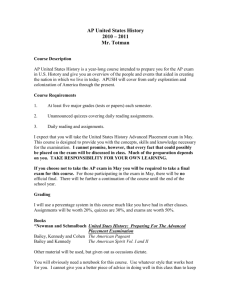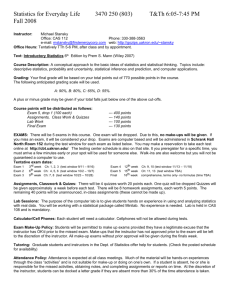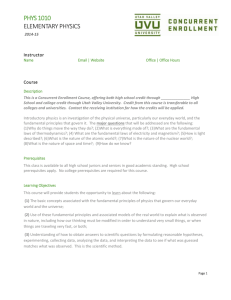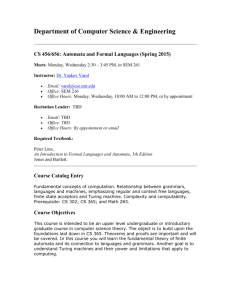Financial Statements and Business Analysis
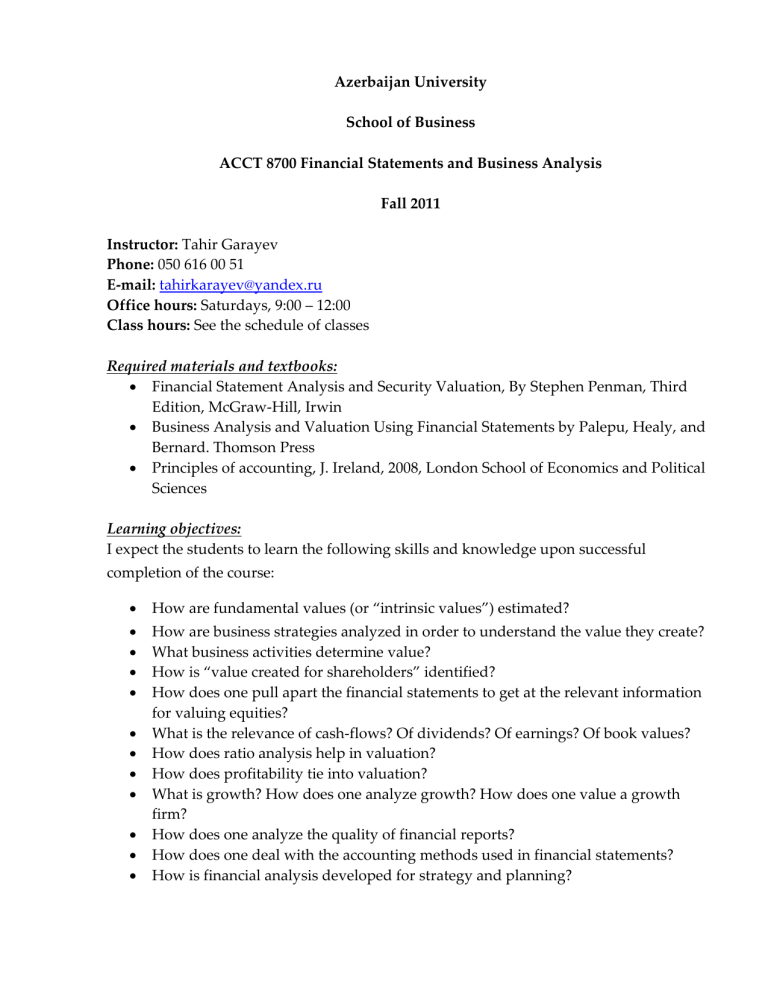
Azerbaijan University
School of Business
ACCT 8700 Financial Statements and Business Analysis
Fall 2011
Instructor: Tahir Garayev
Phone: 050 616 00 51
E-mail: tahirkarayev@yandex.ru
Office hours: Saturdays, 9:00 – 12:00
Class hours: See the schedule of classes
Required materials and textbooks:
Financial Statement Analysis and Security Valuation, By Stephen Penman, Third
Edition, McGraw-Hill, Irwin
Business Analysis and Valuation Using Financial Statements by Palepu, Healy, and
Bernard. Thomson Press
Principles of accounting, J. Ireland, 2008, London School of Economics and Political
Sciences
Learning objectives:
I expect the students to learn the following skills and knowledge upon successful completion of the course:
How are fundamental values (or “intrinsic values”) estimated?
How are business strategies analyzed in order to understand the value they create?
What business activities determine value?
How is “value created for shareholders” identified?
How does one pull apart the financial statements to get at the relevant information for valuing equities?
What is the relevance of cash-flows? Of dividends? Of earnings? Of book values?
How does ratio analysis help in valuation?
How does profitability tie into valuation?
What is growth? How does one analyze growth? How does one value a growth firm?
How does one analyze the quality of financial reports?
How does one deal with the accounting methods used in financial statements?
How is financial analysis developed for strategy and planning?
What determines a firm's P/E ratio? How does one calculate what the P/E should be?
How does one evaluate risk? For equity? For debt?
How does one evaluate an equity research report?
How does one trade on fundamental information?
Course description:
How can you make a significant difference in your organization? One way is to be part of a project that improves the company's performance or launches it in a new direction. The business analyst (BA) plays a key role in the development and execution of company projects. Maybe it's a new product launch or a change to a more efficient software package.
The BA is responsible for gathering input, analyzing the needs of the project, documenting the criteria to be met, sharing information among project team members and presenting findings to company executives. Also this course is designed to prepare you to interpret and analyze financial statements. This course, therefore, explores in greater depth financial reporting topics from the perspective of financial statement users. We develop sufficient understanding of the concepts and recording procedures to enable you to interpret various disclosures in an informed manner. We discuss each financial reporting issue in terms of its effect on assessments of a firm’s profitability and risk. We then apply analytical tools and concepts in competitor analysis, credit and investment decision, bankruptcy prediction, and valuation.
Course Pre-requisites: Principles of Accounting, Business management
Required Computer Skills Prerequisites: Microsoft Windows, Microsoft Office (Word,
Excel and Power Point 2003)
Class activities:
Short cases, quizzes and solving problems. Please come to class prepared to discuss your analysis of the cases and problems. Regular class participation is important to the learning process for you and your classmates. Absences from class will affect your participation grade.
Assignments:
Assignments are due at the end of the class assigned. No late assignments are accepted, nor are faxed or e-mailed assignments. During class discussions, please feel free to make changes to your solutions (or write-up), but do so in a way that clearly indicates that they are the results of class discussion (e.g., using a different color of ink).
Course Structure: The course is organized into three parts:
Part One: Overview of financial statement analysis.
This section emphasizes understanding business activities – planning, financing, investing and operating. It describes strategies underlying business activities and their effect on the financial statements, and it discusses the objectives of analysis. Important tools and techniques in analyzing and interpreting financial statements are illustrated.
Part Two: Business Analysis.
This section describes the accounting measurement and reporting practices underlying financial statements. Presentation is organized around financing (liabilities and equity), investing (assets), and operating (income and cash flow) activities
Part Three: Financial Analysis.
In this section, the processes and methods of financial statement analysis are examined.
The objectives of users and the analytical tools and techniques for meeting those objectives are emphasized. This section demonstrates how analysis tools and techniques enhance users’ decisions – including company valuation and lending decisions. It also shows how financial statement analysis reduces uncertainty and strengthens confidence in making timely business decisions.
Expected Learning Outcomes
By taking this course the student gains knowledge in the field of an ongoing business’s requirements for monitoring and control. The design of the course facilitates the development of an advanced understanding of how companies manage their current business operations, and how they plan for their future operations, as well as to assess expectation of results on different type of action.
After completing the course, the student should be able to:
• identify external and internal factors affecting the business in a firm and evaluate the impact and risk of these factors for a specific business situation,
• compare the impact of different types of business information for an ongoing business,
• use the vocabulary of strategy in order to judge an ongoing business situation,
• apply specific business models to summarize information and to discuss different possible decisions,
• structure and evaluate complex information from different sources,
• analyze and evaluate relationships for information coming from marketing, management, entrepreneurship, financing, and accounting regarding the ongoing business of a firm,
• consider managerial implications from different types of information.
Instruction Evaluation
You are required to complete an Instructor Evaluation Form for this course (you may also choose not to complete the evaluation, but you must indicate so.)
If you need to discuss grade-related issues after the final exam/test, please contact me only after AU has published your course grades (timing when the evaluation is still in the progress).
Grading policy:
The course grade for each student will be determined based on the following activities:
Activity Percentage
Class participation
Cases
Quizzes
Problem solving
10%
10%
10%
10%
Midterm exam
Final exam
20%
40%
Total:
Letter Grade Policy
Letter grade
A+
A
A-
B+
B
B-
C+
C
C-
D
F
100%
Total points
97-100
93-96.9
90-92.9
87-89.9
83-86.9
80-82.9
77-79.9
73-76.9
70-72.9
60-69.9
Below 60
Exams (mid-term and final):
The tests will be based on the assigned readings as well as the contented presented by me and discussed with students in sessions.
Method of Instruction:
Various method of teaching will be employed to encourage proactive involvement of students and make learning process successful. Mostly employed methods and techniques to expect are discussions, lectures and problem-solving.
Case:
Case is to be completed by each student to demonstrate his or her competency in solving real life problem and presenting its findings in the class. Every student is expected to submit his or her own case-project based on real-life issues, which could be related to the company that the student is working for. It is important to mention that students will be penalized for copying other’s works without properly citing them.
Home works (problem solving):
Instructor will assign home-works, each of which must be completed independently by students. Students are encouraged to form group discussions to analyze home-works but are expected to honestly turn in their individual home-work. Home-works are expected to be turned in as hard copies, no faxes and emails are accepted.
In-class quizzes:
There will be quizzes every other lesson to grade the level of student’s preparedness to the classes. Students who receive low grades for quizzes will be considered as students who does not follow class material as well as do homework.
E-mail:
Students can contact me for arranging meetings and asking urgent questions by e-mail.
But I encourage them to contact me in person to discuss substantive matters such as a class absence, exams, or grade assignments.
Policy on Class Attendance
Students are expected to attend all scheduled classes and take all tests
If the student misses a class, the student is still responsible for catching up on the material covered in the absence of that student before coming to the next class session. Therefore, it is responsibility of the student to arrange with student colleagues to obtain notes if he or she misses a class or classes.
Excessive absence: Four or more classes. Depending on the circumstances, the instructor may initiate some kind of penalty with dean’s office.
Policy on Make-Ups
Mid-term and final: do not miss them. There are no exceptions for those.
Home-works are due on the dates announced and late submission means no grade for that home-work.
Requests for make-ups may be granted only under exceptional circumstances.
Avoid requests for reasons of personal convenience;
Any make-up exams, if granted, must be taken prior to the next meeting of the class.
If you miss a test without prior notice or arrangement, no grade (zero grades) is automatically assigned to the missed test.
Class discipline
Please arrive on time.
Do not eat food in class: please use lounge areas.
Cell phones, e-mails, and any possible other electronic devices must be turned
OFF while in class and during the test.
Academic dishonesty
Azerbaijan University has no tolerance for acts of academic dishonesty. The responsibilities of both students and faculty with regard to academic dishonesty are defined by education policy of Azerbaijan University. By teaching this course, I have agreed to observe the entire faculty responsibilities described in that document. By enrolling in this class, you have agreed to observe all of the student responsibilities described in that document. Academic dishonesty in this course includes copying or collaborating during an exam, discussing or divulging the contents of an exam with another student who will take the test, and use of homework solutions from another students.

